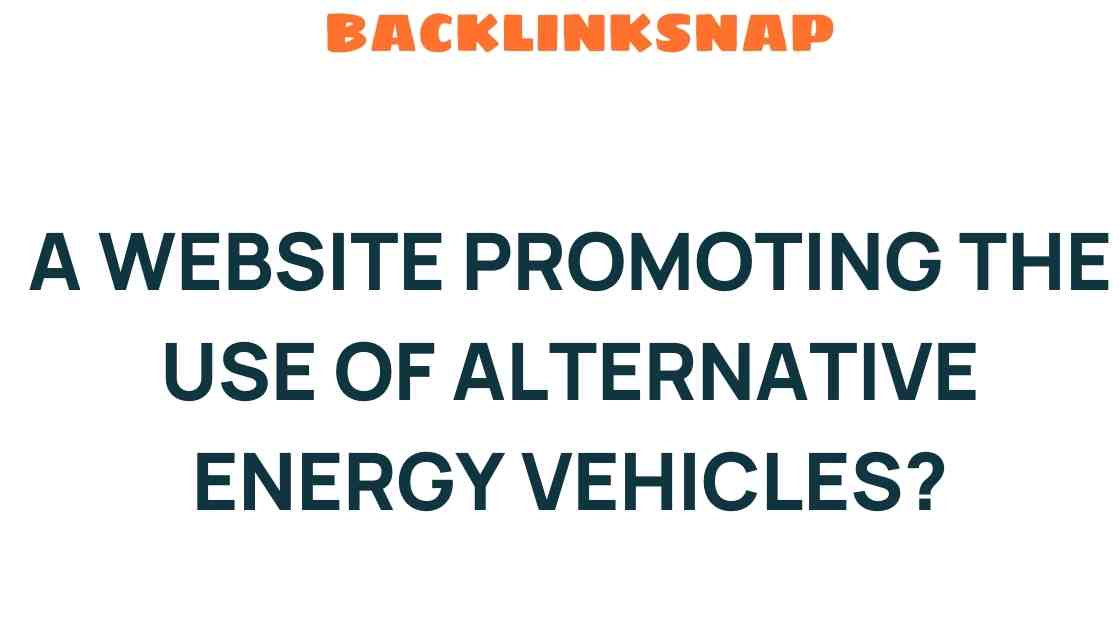Discover the Future: A Website Transforming Alternative Energy Vehicles
In today’s rapidly evolving world, the demand for sustainable transport solutions has never been more critical. With the looming threat of climate change and the pressing need to reduce our carbon footprint, alternative energy vehicles are taking center stage. This article explores how innovation in green technology is transforming the landscape of eco-friendly transportation, highlighting the role of electric cars and renewable energy in creating a cleaner, more sustainable future.
The Rise of Alternative Energy Vehicles
Alternative energy vehicles (AEVs) represent a significant shift away from traditional gasoline-powered cars. These vehicles utilize various energy sources, including electricity, hydrogen, and biofuels, to power their engines. The global automotive industry is witnessing a paradigm shift as manufacturers embrace these eco-friendly alternatives, driven by consumer demand and stringent environmental regulations.
The transition to AEVs is not just about reducing emissions; it’s about rethinking our entire approach to transportation. As we explore the different types of alternative energy vehicles, it’s essential to understand their impact on our environment and society.
Electric Cars: The Vanguard of Clean Driving
Electric cars (EVs) are perhaps the most recognized form of alternative energy vehicles. They operate entirely on electricity, using batteries to power electric motors. The advantages of EVs extend beyond their zero tailpipe emissions:
- Cost-Effectiveness: With fewer moving parts than internal combustion engines, electric cars are cheaper to maintain.
- Performance: Electric motors deliver instant torque, resulting in quick acceleration and a smooth driving experience.
- Energy Efficiency: EVs convert over 60% of electrical energy from the grid to power at the wheels, significantly higher than gasoline vehicles.
Leading manufacturers like Tesla, Nissan, and Chevrolet are investing heavily in electric technology, providing consumers with more choices than ever. As battery technology continues to improve, the range of electric cars is expanding, making them a viable option for more drivers.
Hydrogen Fuel Cells: Another Dimension of Green Technology
While electric cars dominate the conversation around alternative energy vehicles, hydrogen fuel cell vehicles (FCVs) are also making headway. These vehicles generate electricity through a chemical reaction between hydrogen and oxygen, emitting only water vapor as a byproduct. Some advantages include:
- Fast Refueling: Hydrogen vehicles can be refueled in minutes, comparable to gasoline cars.
- Range: FCVs often provide longer ranges than many electric vehicles, making them appealing for long-distance travel.
- Heavy-Duty Applications: Hydrogen technology is being explored for trucks and buses, where battery weight can be a significant concern.
The challenge, however, lies in infrastructure. Currently, hydrogen refueling stations are sparse, limiting the widespread adoption of FCVs. Nevertheless, governments and businesses are investing in this technology, paving the way for a more comprehensive hydrogen infrastructure.
Biofuels and Other Alternatives
In addition to electric and hydrogen vehicles, biofuels—derived from organic materials—also play a crucial role in the alternative energy vehicle landscape. These fuels can be blended with traditional gasoline or used in modified engines, offering a transitional solution towards cleaner fuel sources.
Moreover, other innovations like compressed natural gas (CNG) vehicles and plug-in hybrids are gaining traction. Plug-in hybrids combine electric and gasoline power, offering flexibility for drivers who may not have access to charging stations.
The Environmental Impact of AEVs
Transitioning to alternative energy vehicles significantly reduces greenhouse gas emissions and reliance on fossil fuels. According to the U.S. Department of Energy, electric vehicles can reduce carbon dioxide emissions by over 50% compared to conventional vehicles, depending on the source of electricity used.
Moreover, the life cycle analysis of vehicles shows that even when considering the emissions from manufacturing batteries, electric cars still have a lower environmental impact. The move towards renewable energy sources, such as solar and wind, further enhances the sustainability of electric vehicles.
Challenges and the Road Ahead
Despite the promising future of alternative energy vehicles, challenges remain. High upfront costs, limited charging infrastructure, and range anxiety are common concerns among potential buyers. However, as technology advances and economies of scale come into play, these barriers are gradually diminishing.
Governments around the world are implementing policies to incentivize the purchase of AEVs, ranging from tax credits to rebates and investments in charging infrastructure. Consumer awareness is also growing, with more people recognizing the benefits of eco-friendly transportation.
Conclusion
As we stand at the cusp of a transportation revolution, the potential of alternative energy vehicles to reshape our world is immense. With ongoing advancements in green technology, electric cars, hydrogen fuel cells, and biofuels are not just dreams of the future—they are our present and our path forward. By embracing these innovations, we can move towards a more sustainable, eco-friendly future, significantly reducing our environmental impact.
For more information on alternative energy vehicles and to explore the latest developments in eco-friendly transportation, visit this website dedicated to sustainable transport solutions. Together, we can drive the change towards a greener planet.
FAQs
- What are alternative energy vehicles?
Alternative energy vehicles are vehicles that use non-traditional fuels, such as electricity, hydrogen, or biofuels, to operate, reducing their environmental impact. - How do electric cars work?
Electric cars operate on electricity stored in batteries, which power electric motors to drive the vehicle, producing zero tailpipe emissions. - What is the environmental impact of alternative energy vehicles?
AEVs significantly lower greenhouse gas emissions compared to traditional gasoline vehicles, especially when powered by renewable energy sources. - Are hydrogen fuel cell vehicles practical?
While they offer advantages like quick refueling and longer ranges, the lack of widespread hydrogen refueling infrastructure is a current limitation. - What incentives are available for purchasing alternative energy vehicles?
Many governments offer tax credits, rebates, and other incentives to encourage the adoption of eco-friendly vehicles. - Can biofuels replace gasoline?
While biofuels can be blended with gasoline, they are typically seen as a transitional solution rather than a full replacement.
This article is in the category Digital Marketing and created by BacklinkSnap Team




